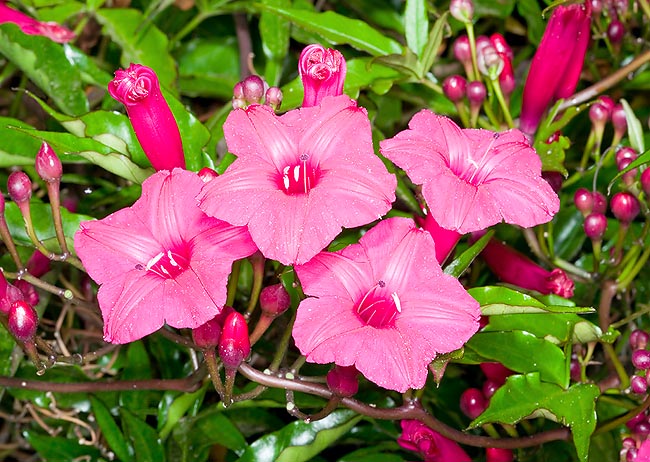Family : Convolvulaceae

Text © Pietro Puccio

English translation by Mario Beltramini

The Ipomoea horsfalliae is an evergreen climber, rich of flowers, for the warm climates © Giuseppe Mazza
The name of the genus is the combination of the Greek words “ips” = worm and “hómoios” = similar, with possible reference to the voluble stems; the species is honoured to the English botanist Charles Horsfall (1776-1846).
Common names: cardinal creeper, crimson ipomoea, Horsfall’s morning glory, Kuhio-vine, lady Doorly’s morning-glory, lady Doorly vine, pink morning glory, prince Kuhio-vine, princess vine, prince’s-vine (English); ipomée de Horsfall (French); campainha vermelha, ipoméia-de-cera, ipoméia-rubra, glória-das-manhãs, princesa-dos-cipós, trepadeira-cardeal (Portuguese-Brazil); campanitas de coral (Spanish); Kardinalswinde (German).
The Ipomoea horsfalliae Hook. (1834) is an evergreen climber with milky sap with tuberous roots and thin stems, which, with the time, tend to lignify, reaching the 2-8 m of length. It has alternate, glossy dark green leaves, up to 15 cm long, palmate-lobate, deeply divided into 3-7 lobes with wavy edges, entire or dentate.
The ruby red to magenta violet flowers, of 4-7 cm of diameter and with a length of 4-6 cm, are produced in great quantity in axillar cymes; they are funnel-shaped, stellate, waxy, with pointed lobes.
The fruits are sub-globular, 13-16 mm long capsules, containing 6-7 mm long dark brown seeds, provided with a crown of tawny silky hairs, about 1 cm long, which help their dispersion. It reproduces by seed, which is to be scarified and soaked in water for 24 hours in order to stimulate the germination, by cutting, layering and grafting.
Of moderate growth, it’s considered to be one of the most ornamental climbers, both for the leaves and for the flowers produced abundantly, especially in winter months; it is cultivable, therefore, in the open ground only in the tropical, subtropical and, marginally, in warm temperate climate zones, in sheltered position. Temperatures close to 0 °C destroy its aerial part, thus compromising the blooming, but the plant grows again in summer from the tuberous roots, at least up to temperatures close to -6 °C, under these, in fact, the whole plant will die. In order not to compromise the flowering, the temperatures must keep over the 10 °C, even if sporadic and very short lasting decreases may be cause only of limited and temporary damages.
For a luxuriant growth, it needs of loose soil, rich of organic substance, perfectly draining and an exposition in full sun, or, at most, in slight shade. Watering must be regular and abundant in summertime, whilst in autumn-winter the soil must be partly dried up before watering again. The fertilizing operations are to be done in spring-summer with organic or chemical fertilizers, possibly balanced and of slow release.
It bears well the prunings, which are to be done in spring, by the beginning of the vegetative time, for containing its dimensions as well as for stimulating and abundant blooming. It is ideal for covering pylons, fences, gates, pergolas or as climber on the trees. Where the permanent cultivation in open air is not possible, it may be cultivated in pot, with the necessary supports and the same modalities aforementioned, for the decoration of luminous verandas, winter gardens and greenhouses.
The plant has a reputation of being of difficult reproduction, the fructification is, in fact, rather irregular also in the origin countries, where the flowers are pollinates almost exclusively by the hummingbirds; also the cuttings root with difficulty and for a better outcome, it is advisable to utilize greenhouses and bottom heat.
The plant is very common, and nowadays is naturalized, in the Hawaii, where it was introduced, in his garden at Waikiki, by the prince Kuhio (1871-1922) of the dynasty Kauakaua, the last of the kingdom of the Hawaii, who fought for the rights of the natives after the annexation to the USA (1898), and from this come some of its common names.
→ To appreciate the biodiversity within CONVOLVULACEAE family please click here.
